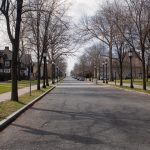Brendan W. Clark ’21
Alumni Contributor
In light of a recent circular made this week by the Student Government Association, the following notes on the College’s history may be of interest to many in the student body.
Make no mistake—students and the administration are free to debate the single plaque which appears on one of the two cannons on the main quad acknowledging Trinity students that fought for the Union and fought for the Confederacy in the Civil War. That is a discrete issue and one which has been debated in the pages of the Tripod previously (see the editions of September 26, 2023 and November 19, 2019).
However, any suggestion that the cannons themselves should be removed ignores the plain text of history. The SGA’s latest missive is not clear—and requires clarification—in its comments on the targeting of the cannons’ orientation and its loose use of the plural “plaques.”
Specifically, one line of the Student Government Association’s message is egregiously incorrect, viz. the suggestion that “contention and pain” is “exacerbated by the cannons’ orientation towards the Hartford community.” This disregards the history of the cannons and what the cannons stand for.
The U.S.S. Hartford was a ship commissioned by the Union to fight against the Confederacy, commanded by the famed Admiral David Farragut. The Hartford was responsible, in no small part, for Union success at the Battle of New Orleans and the subsequent blockades on the Mississippi which crippled the Confederacy. Indeed, it is said that the Hartford gave rise to Farragut’s line “damn the torpedoes, full speed ahead” at the Battle of Mobile Bay. The cannons—separate from the single contested plaque—are a symbol of the success of the Union cause against the pernicious institution of slavery, not a symbol of its promotion.
It bears mention, too, that any concerns about some historical, invidious purpose in the orientation of the cannons (which SGA has provided no citation to) is belied by the fact that it was the City of Hartford itself who transferred the cannons from the City’s possession to Trinity’s in 1950. Not to mention that the cannons orientation, when placed in 1950, would more accurately have been facing the bus (and formerly trolley repair depot) that ran along the length of Broad Street where the present Learning Corridor stands today, rather than the city itself.
The eminent Peter Knapp ’65, the man who wrote Trinity College in the Twentieth Century—authored the foremost historical study on the cannons in a September 1995 edition of the Trinity Reporter. Every student should read it to understand the importance of the U.S.S. Hartford in preserving the Union and in vanquishing the Confederate cause. Every student should also read it to recall the story of how the cannons arrived at Trinity and the origins of the contested plaque itself.
Additionally, students should appreciate the distinction between the single contested plaque and the second plaque, on another of the cannons, which acknowledges the service of Bishop Thomas Church Brownell’s nephew, Henry Howard Brownell ’41, HON ’44. Henry Brownell was personal secretary to Admiral Farragut and was, in fact, a supporter of abolition, as evidenced by his notable poem, “Suspira Ensis” (“Sigh the Sword”), on the follies of the Confederate crusade:
‘But now to the long, long Night
They pass, as they ne’er had been—
A stranger and sadder sight
Than ever the sun hath seen.
For his willing beams illuminated
A vast and a sullen train
Going down to the gloom—
One wretched and drear refrain
The only line on their tomb,—
“They died and they died in vain.”’
“They died and they died in vain”—hardly a view that a supporter of the Confederate cause would endorse and hardly a plaque worth removing.
Brownell’s plaque should remain. The cannons should remain. The student body may seek redress to the other plaque as they please. The lesson to be learned: be more precise in the scope of a contest, and assess the full history implicated, lest we accidently topple a monument that attests to the Union’s victory over the Confederacy and its reprobate cause.





A dramatic site was selected for the placement of the cannons to honor the City of Hartford, for which their ship was named, and the Union cause. Any other interpretation of the siting of the cannons is fanciful.
These two cannons unlike the Southern monuments erected in public spaces to glorify the Confederacy and reinforce Jim Crow, remember with respect and affection the soldiers of the Union, including many Trinity alumni, who suffered and died to defeat slavery and its exponents.